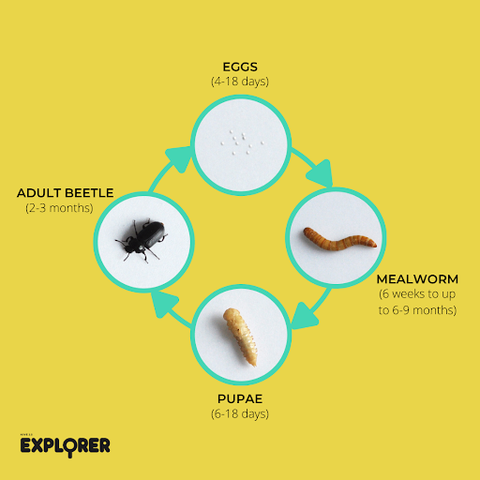Mealworm Menu: What do Mealworms Eat?
If you google: Can plastic be digested?, the internet will tell you that “Plastic is inert, it can’t be digested or broken down.”
Luckily, our mealworm friends here at Livin Farms are ready for their moment of fame because they have a secret that they’ve been keeping.

Spoiler alert: Mealworms can eat plastic (shhh, keep reading)
Just FYI: Mealworms are the famous larval form of the Tenebrio molitor darkling beetle species. In other words, after beetles lay their eggs, you get little baby worms - packed with protein, the ability to crawl across surfaces at inhumane speeds, and the stomach capacity beyond our basic understanding.

Those are the mealworms on the right!
So, what do the mealies eat?
The internet and our basic knowledge of scavenging insects will tell us that mealworms can eat just about everything. Although this is not entirely untrue, it is important for us to understand why a certain proportion of foods is probably better than others - so that our mealworms are being fed the right nutrients, and hygiene levels are being maintained.
1. Polystyrene
In 2020, it was confirmed by researchers at Stanford University, California that mealworms can in fact consume and break down various forms of plastic including the kind most widely used in packaging, take-out containers and insulation, polystyrene.
What’s even cooler is that apart from actually being able to digest the polystyrene, they are actually take-in the toxic hexabromocyclododecane chemicals and subsequently excrete them after about 48 hours.

This particular piece of research has been incredibly important to farmers, fishermen & breeders globally, because there has always been a worry that mealworms might be unsafe to feed our livestock if they were contaminated with microplastics in their system. Well, fear no more!
2. Dry Grains
Mealworms enjoy what is called a ‘bedding’ of dry grains which they both eat and burrow in. Everyone needs a comfy mattress to lay on!
Our go-to preference is typically instant oats or quick-cook oatmeal, and we try to avoid steel-cut oats despite their protein & fiber content because they’re a little too tough for our insect friends to bite into. Alternatively, wheat bran or bread crumbs are always a fine option.

In the Hive Explorer, we like to add about 100-150g of oats every 3-4 days for the mealworms at the bottom tray, with an extra 10-15g up onto the beetle tray & the baby mealworm tray - so that everybody has something to snack on. Several sources recommend about a 2-3 inch layer as an alternative source of measurement.
💡Pro tip: Just as you would feed hardened bread that’s about to go stale to birds - feel free to do the same with the mealies instead of throwing it out.
3. Fruit & Veg
Once your mealies are set with their home base, you can go ahead and begin feeding them your food waste in the form of fruits & vegetables. There’s no complex formula to this, because mealworms enjoy lettuce, potato peels, apples, banana peels, celery, even dragon fruit! The catch is to feed them whatever it is that you are not being able to use-up in the kitchen or whilst snacking.
However, you want to be careful about the amount of moisture you are producing in your Hive Explorer, because excess moisture can cause bacteria & mold formation - which can be harmful to your mealworms, and to your own health. A simple tip for this is to limit the amount of ‘wet’ food to only 30% of the total food in your container.
Also also also, you'll be seeing an aesthetic banana peel in the photograph below. Along with the limit of 30% wet food, you're also suggested to cut your fruit & veg into nail-sized chunks for ease of consumption by the beetles & mealworms.

Reminder: Cut your food scraps into bite-sized pieces, don't do what we did with our banana peel!
💡Pro tip: Refrigerate your food scraps to feed the mealies the next day, or use them to make an excellent vegetable stock which you can use in soups, curries, or while cooking rice & pasta (Courtesy of Punam Chopra from Spicebox Organics)
Many suggest feeding the mealies carrots, as they have a manageable moisture content, and do not rot quickly. Remember to periodically remove large pieces of food that may go uneaten, and sanitise your containers after removing all your insects in case mold does form.
4. Meat
Getting to everyone’s favorite question: Can the mealworms eat meat?
It’s true, mealworms are great fans of decaying organic matter, and it’s not surprising to see them munching on their own brothers in desperate times. However, we do not recommend feeding your mealworms meat, treat them as vegetarians. The health of the insects can be severely disrupted if there are pieces of meat left behind, and can cause a host of diseases if later consumed by humans.
⭐Just a reminder to learn about the environmental problems that insect farming can help us fix in this blog

If your questions have gone unanswered, feel free to check out the Frequently Asked Questions page on our website.

